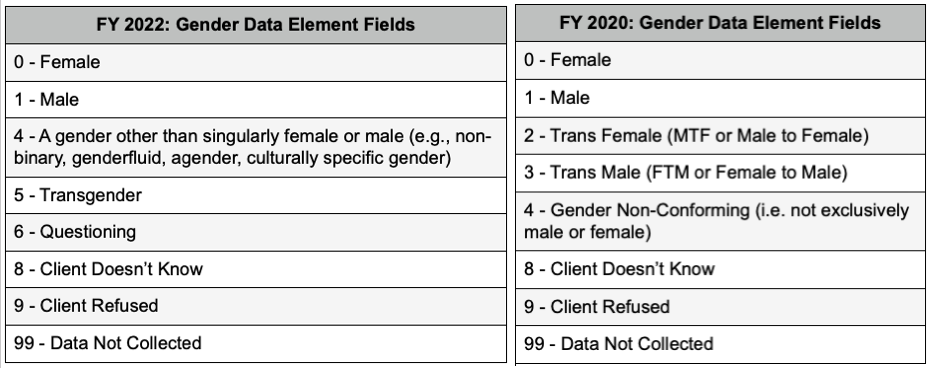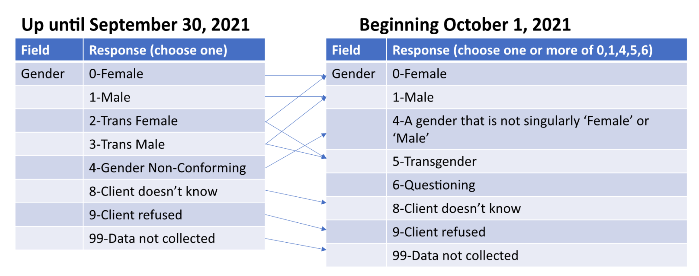FY 2022 Gender: Logic and Updates
HUD released the FY2022 HMIS Data Standards and they went live on October 1, 2021. Gender is one of many Universal Data Elements(UDEs) that are to be collected for all clients, programs and project types.The Gender fields changed rather significantly and have evolved into a multi-select picklist. This article will discuss some of the changes that were caused by the updated data standards, an overview of the reports that were impacted and how they changed and some helpful resources from HUD to bookmark for reference.
Gender Updates
In prior years, only one gender option was allowed to be selected. HUD now allows any combination of genders to be selected for individuals to self-identify (with the exception of the following single select options: Client Doesn’t Know, Client Refused and Data Not Collected).
In addition to the now multi-select picklist, some of the categories in the gender field have been updated. Review the table below to reference the FY2020 and FY2022 Data Standards options for gender. 
Report Impact
All federal, general and custom reports were impacted by the data standards updates.
HUD logic for the HMIS CSV/XML Export, Annual Performance Review(APR) and Emergency Solutions Grants (ESG) Consolidated Annual Performance and Evaluation Report (CAPER), and the Projects for Assistance in Transition from Homelessness (PATH) Annual Report are available for review in the HUD Resources section later in this article.
This federal logic was utilized to update and rework all federal and general reports found in the Report Library. Custom reports were updated by working with Bitfocus (your BFF or community’s local team) to determine which logic best fit the needs of the community and report. The table below contains an overview of the Gender logic utilized for all federal and general reports. 
For data that was entered prior to October 1, 2021 and utilized the FY2020 Data Standards gender options - the mapping for federal and general reports is outlined in the table below.
 Example: if a client chose Gender Non-Conforming for gender prior to October 1, 2021, they would now show in reports as “A gender that is not singulary female or male (e.g., non-binary, genderfluid, agender, culturally specific gender)” in reports.
Example: if a client chose Gender Non-Conforming for gender prior to October 1, 2021, they would now show in reports as “A gender that is not singulary female or male (e.g., non-binary, genderfluid, agender, culturally specific gender)” in reports.
Note: Some reports (e.g., APR, CAPER, CE-APR) utilize "No Single Gender" synonymously with “A gender that is not singulary female or male (e.g., non-binary, genderfluid, agender, culturally specific gender)”.
HUD Resources
Below are links to helpful resources from HUD with definitions, descriptions, programming specifications and more.
FY 2022 Interactive HMIS Data Standards Tool
FY 2022 HMIS Data Dictionary - Version 1.2
FY 2022 HMIS Data Standards Manual - Version 1.2
HMIS Standard Reporting Terminology Glossary
CoC APR and ESG CAPER HMIS Programming Specifications
Data Exchange Resources (CSV/XML Programming Specifications)